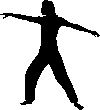Any matter in the physical world can be measured. We weigh things, we record temperatures, chart distances and the passage of time, we can determine electrical charges and the amount of force exerted on objects, we are able to calculate the speed of light, describe energy as joules and use candela scales for measuring the intensity of light - and the list goes on and on.
Measurements answer questions about how many, how big, how long, how much? They allow us to make comparisons, make changes and make it possible to describe and record our interesting world. Sometimes it is appropriate to estimate measures or to be 'in the ball park', for example when we might say there are around 20 sweets in a packet or there are about four or five minutes to go before the
end of a film. But there are many instances when being quite close isn't close enough.
Scientists in particular have to very accurate when they measure. The more precise a measurement needs to be the more important it is that the measuring tools are calibrated to small units of measurement. It would not be good enough for a rocket scientist to give approximate measures of distance for lunar landing crafts, or for a surgeon to cut fairly close to the heart; they need to be
accurate to the millimetre.
Very accurate forms of measurement are relatively new. The idea of measuring and comparing goes way back in the history of mathematics. I am looking at a picture that was brought from Egypt. It shows a Pharaoh watching his attendants weight containers. Measuring things figures prominently in paintings and carvings that were made in Ancient Egypt.
The earliest measurements were based on very portable tools - body parts! A main measurement 5,000 years ago for the Egyptians was the cubit. This was the length from fingertip to elbow. The Greeks used a different measure - the finger, while the Romans used the foot. A foot was based on the
average size of a Roman man's foot. The same measurement is used still in many countries and today is a standard 12 inches. Do you t
hink the average size of a man's foot is still the same today? The foot is broken into twelve smaller units, inches. Medieval Britain saw the introduction of the inch,
which was as long as five barleycorns. This turned out to be about the same length as the top joint of a man's thumb. That was a convenient discovery, because it was so much easier to measure with the top of a thumb that with five barleycorns!
Some of those old and often strange measures are still used today. Even now horse's hei
ghts are measured in 'hands'. The average size of a hand (measured across the palm) must have been about 4 inches or about 10 centimeters because that is the size of a 'hand'. How many 'hands' do you think a
pony might be? A yard (36 inches) was measured, and often still is by people selling fabric, by holding cloth at the end of your nose and stretching it for the full length of your arm. Try it and see how close to a yard your reach is. But what about a metre (close to 39 inches) of fabric? Do the same as when you measure a yard but turn your head to the side. This extends the length by the
distance between your nose and your ear. So how far is that? Measure your face and check that measure!
Artists make use of what they know about the sizes of parts of the body. If you stretch out your arms, the distance from your middle finger tip on your right hand to the same finger tip on your left hand - known as a reach - is about the same as your height! Knowing that helps you measure the
length of things or even the circumference of a tree. It also helps artists make sure they don't draw a person with arms that are too short or too long. Other pieces of information that help artists with proportion is knowing that the length of your hand is about the length of your face from chin to forehead. The length of your ears is about the same size as the space between your eyes and your
mouth. Well, it seems as though we have very proportional bodies.
Talking about horses, w
hich we were earlier, animals as well as body parts played an important part in the development of our measuring systems. Until very recently, the strength of a vehicle's engine was described in 'horsepower'. Horsepower is a unit of measurement describing the weight that
one horse could move or, put another way, how much power it exerts when pulling an object. What other interesting things can you find out about units of measure?








